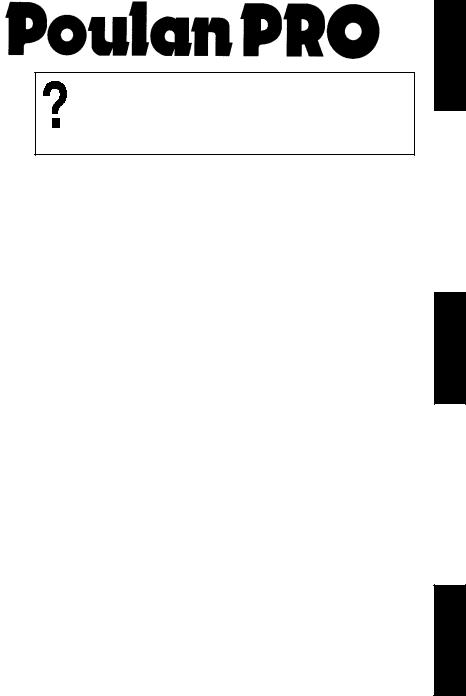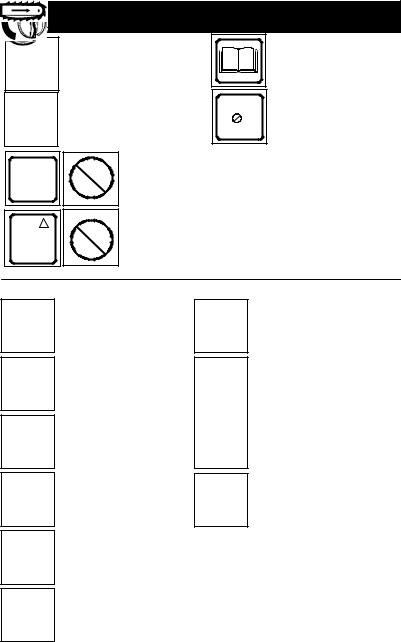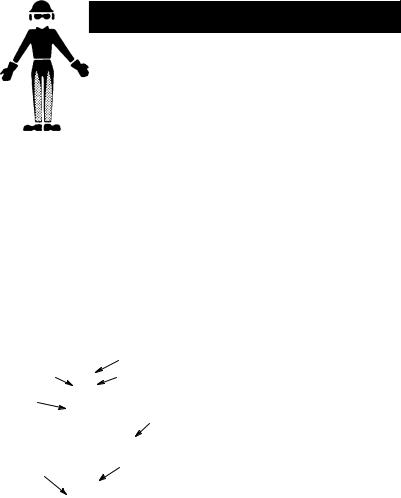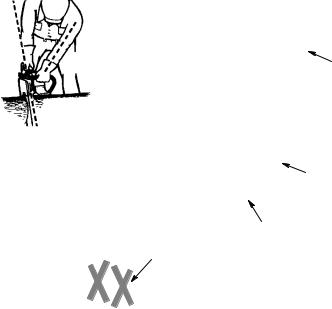Poulan PP3516AVX, PP4218AVX User Manual

R
Please do not return unit to retailer.
Por favor, no devuelva el aparato al lugar de compra.
Veuillez ne pas retourner l’outil au détaillant.
1-800-554-6723
www.poulan--pro.com
Instruction Manual
Manual de Instrucciones
Manuel d’Instructions
ENGLISH
PP3516AVX / PP4218AVX
WARNING:
Read and follow all Safety Rules and Operating Instructions before using this product. Failure to do so can result in serious injury.
ADVERTENCIA:
Lea el manual de instrucciones y siga todas las advertencias e enstrucciones de seguridad. El no hacerlo puede resultar en lesiones graves.
AVERTISSEMENT:
Lire le manuel d’instructions et bien respecter tous les avertissements et toutes les instructions de sécurité. Tout défaut de le faire pourrait entraîner des blessures graves.
Poulan PRO |
Poulan PRO |
1030 Stevens Creek Road |
5855 Terry Fox Way |
Augusta, GA 30907 |
Mississauga, Ontario L5V 3E4 |
545137248 11/30/06
ESPAÑOL
FRANÇAIS

IDENTIFICATION OF SYMBOLS
WARNING! This chain saw can be dangerous! Careless or improper use can cause serious or even fatal injury.
Always wear appropriate ear protection, eye protection and head protection.
|
Read and understand the |
|
instruction manual before |
|
using the chain saw. |
XX_ |
Measured maximum kick- |
|
back value without chain |
|
brake for the bar and chain |
|
combination on the label. |
Always use two hands when operating the chain saw.
WARNING! Contacting the guide bar tip with any ob-
ject should be avoided; tip contact may cause the guide bar to move suddenly upward and backward, which may cause serious injury.
Starting Reminder
Move ON/STOP switch to the ON position.
Slowly press primer bulb 6 times.
Pull choke/fast idle lever out to the full extent (to
the FULL CHOKE position).
Pull the starter rope sharply 5 times with your
right hand.
Push the choke/fast idle lever in to the HALF CHOKE position.
Pull the starter rope sharply with your right hand until
the engine starts.
Chain Tensioning
Lift lever on bar knob and turn counterclockwise 1 turn to loosen bar clamp.
Turn adjusting wheel (downward direction) to tension chain until
chain solidly contacts bottom of guide bar rail.
While lifting tip of guide bar, tighten bar knob (clockwise) securely.
Hand tighten only! Return lever on bar knob to original position.
2

SAFETY RULES
 WARNING: Always disconnect
WARNING: Always disconnect
spark plug wire and place wire where it cannot contact spark plug to prevent accidental starting when setting up, transporting, ad-
justing or making repairs except carburetor adjustments.
Because a chain saw is a high-speed woodcutting tool, special safety precautions must be observed to reduce the risk of accidents. Careless or improper use of this tool can cause serious injury.
PLAN AHEAD
S Read this manual carefully until you completely understand and can follow all safety rules, precautions, and operating instruc-
tions before attempting to use the unit.
SRestrict the use of your saw to adult users who understand and can follow safety rules, precautions, and operating instructions found in this manual.
SWear protective gear. Always use steel-toed safety footwear with non-slip soles; snug-fit- ting clothing; heavy-duty, non-slip gloves; eye protection such as non-fogging, vented goggles or face screen; an approved safety hard hat; and sound barriers (ear plugs or mufflers) to protect your hearing. Regular users should have hearing checked regularly as chain saw noise can damage hearing. Secure hair above shoulder length.
Hearing |
Safety Hat |
Protection |
|
Snug |
Protection |
|
|
Fitting |
Heavy Duty |
Clothing |
Gloves |
Safety |
Chaps |
Shoes |
|
SKeep all parts of your body away from the chain when the engine is running.
SKeep children, bystanders, and animals a minimum of 30 feet (10 meters) away from the work area. Do not allow other people or animals to be near the chain saw when
starting or operating the chain saw.
SDo not handle or operate a chain saw when you are fatigued, ill, or upset, or if you have taken alcohol, drugs, or medication. You must be in good physical condition and mentally alert. Chain saw work is strenuous. If you have any condition that might be aggra-
vated by strenuous work, check with your doctor before operating a chain saw.
SCarefully plan your sawing operation in advance. Do not start cutting until you have a clear work area, secure footing, and, if you are felling trees, a planned retreat path.
OPERATE YOUR SAW SAFELY
SDo not operate a chain saw with one hand. Serious injury to the operator, helpers, bystanders or any combination of these persons may result from one-handed operation. A chain saw is intended for two-handed use.
SOperate the chain saw only in a well-venti- lated outdoor area.
S Do not operate saw from a ladder or in a tree.
SMake sure the chain will not make contact with any object while starting the engine.
Never try to start the saw when the guide bar is in a cut.
SDo not put pressure on the saw at the end of the cut. Applying pressure can cause you to lose control when the cut is completed.
S Stop the engine before setting the saw down.
SDo not operate a chain saw that is damaged, improperly adjusted, or not completely and securely assembled. Always replace bar, chain, hand guard, or chain brake immediately if it becomes damaged,
broken or is otherwise removed.
SWith the engine stopped, hand carry the chain saw with the muffler away from your body, and the guide bar and chain to the rear, preferably covered with a scabbard.
MAINTAIN YOUR SAW IN GOOD WORKING ORDER
SHave all chain saw service performed by a qualified service dealer with the exception of the items listed in the maintenance section of this manual. For example, if improper tools are used to remove or hold the flywheel when servicing the clutch, structural damage to the flywheel can occur and
cause the flywheel to burst.
SMake certain the saw chain stops moving when the throttle trigger is released. For correction, refer to CARBURETOR ADJUSTMENT.
S Never modify your saw in any way.
S Keep the handles dry, clean, and free of oil or fuel mixture.
S Keep fuel and oil caps, screws, and fasteners securely tightened.
SUse only Poulan PRO accessories and replacement parts as recommended.
HANDLE FUEL WITH CAUTION
S Do not smoke while handling fuel or while operating the saw.
SEliminate all sources of sparks or flame in the areas where fuel is mixed or poured. There should be no smoking, open flames, or work that could cause sparks. Allow en-
gine to cool before refueling.
SMix and pour fuel in an outdoor area on bare ground; store fuel in a cool, dry, well ventilated place; and use an approved, marked container for all fuel purposes. Wipe up all fuel spills before starting saw.
S Move at least 10 feet (3 meters) from fueling site before starting engine.
STurn the engine off and let saw cool in a non-combustible area, not on dry leaves,
3

straw, paper, etc. Slowly remove fuel cap and refuel unit.
SStore the unit and fuel in an area where fuel vapors cannot reach sparks or open flames from water heaters, electric motors or switches, furnaces, etc.
KICKBACK
 WARNING: Avoid kickback which
WARNING: Avoid kickback which
can result in serious injury. Kickback is the backward, upward or sudden forward motion of the guide bar occurring when the saw chain near the upper tip of the guide bar contacts any object such as a log or branch, or
when the wood closes in and pinches the saw chain in the cut. Contacting a foreign object in the wood can also result in loss of chain saw control.
SRotational Kickback can occur when the moving chain contacts an object at the upper tip of the guide bar. This contact can cause the chain to dig into the object, which stops the chain for an instant. The result is a lightning fast, reverse reaction which kicks the guide bar up and back toward the operator.
SPinch-Kickback can occur when the the
wood closes in and pinches the moving saw chain in the cut along the top of the guide bar and the saw chain is suddenly stopped. This sudden stopping of the chain results in a reversal of the chain force used to cut wood and causes the saw to move in the opposite direction of the chain rotation. The saw is driven straight back toward the operator.
S Pull-In can occur when the moving chain contacts a foreign object in the wood in the cut along the bottom of the guide bar and the saw chain is suddenly stopped. This sudden stopping pulls the saw forward and away from the operator and could easily cause the operator to lose control of the saw.
Avoid Pinch-Kickback:
S Be extremely aware of situations or obstructions that can cause material to pinch the top of or otherwise stop the chain.
S Do not cut more than one log at a time.
SDo not twist the saw as the bar is withdrawn from an undercut when bucking.
Avoid Pull-In:
SAlways begin cutting with the engine at full speed and the saw housing against wood.
S Use wedges made of plastic or wood. Never use metal to hold the cut open.
Kickback Path
Obstructions
Clear
Working Area
REDUCE THE CHANCE OF KICKBACK
S Recognize that kickback can happen. With a basic understanding of kickback, you can reduce the element of surprise
which contributes to accidents.
SNever let the moving chain contact any object at the tip of the guide bar.
SKeep the working area free from obstructions such as other trees, branches, rocks, fences, stumps, etc. Eliminate or avoid any obstruction that your saw chain could hit while you are cutting. When cutting a branch, do not let the guide bar contact branch or other objects around it.
SKeep your saw chain sharp and properly tensioned. A loose or dull chain can increase the chance of kickback occurring. Follow manufacturer’s chain sharpening and maintenance instructions. Check tension at regular intervals with the engine stopped, never with the engine running. Make sure the bar nuts are securely tight-
ened after tensioning the chain.
SBegin and continue cutting at full speed. If the chain is moving at a slower speed, there
is greater chance of kickback occurring. S Cut one log at a time.
S Use extreme caution when re-entering a previous cut.
SDo not attempt cuts starting with the tip of the bar (plunge cuts).
SWatch for shifting logs or other forces that could close a cut and pinch or fall into chain.
SUse the Reduced--Kickback Guide Bar and Low--Kickback Chain specified for your saw.
MAINTAIN CONTROL
Stand to left of the
Thumb on underside of
handlebar
Never hand
Elbow locked
Thumb on underside of handlebar
SKeep a good, firm grip on the saw with both hands when the engine is running and don’t let go. A firm grip will help you reduce kickback and maintain control of the saw. Keep the fingers of your left hand encircling and your left thumb under the front handlebar. Keep your right hand com-
4

pletely around the rear handle whether your are right handed or left handed. Keep your left arm straight with the elbow locked.
SPosition your left hand on the front handlebar so it is in a straight line with your right hand on the rear handle when making
bucking cuts. Never reverse right and left hand positions for any type of cutting.
SStand with your weight evenly balanced on both feet.
SStand slightly to the left side of the saw to keep your body from being in a direct line
with the cutting chain.
SDo not overreach. You could be drawn or thrown off balance and lose control of the saw.
SDo not cut above shoulder height. It is difficult to maintain control of saw above shoulder height.
KICKBACK SAFETY FEATURES
 WARNING: The following features are included on your saw to help reduce the
WARNING: The following features are included on your saw to help reduce the
hazard of kickback; however, such features will not totally eliminate this danger. As a chain saw user, do not rely only on safety devices. You must follow all safety precautions, instructions, and maintenance in this manual to help avoid kickback and other forces which can result in serious injury.
SReduced--Kickback Guide Bar, designed with a small radius tip which reduces the size of the kickback danger zone on the bar tip. A Reduced--Kickback Guide Bar has been demonstrated to significantly reduce the number and seriousness of kickbacks when tested in accordance with safety requirements for gasoline powered chain saws as set by ANSI B175.1.
Reduced Kickback Symmetrical Guide Bar
 Small Radius Tip
Small Radius Tip
Symmetrical
Radius Tip
S Low--Kickback Chain, designed with a contoured depth gauge and guard link which deflect kickback force and allow wood to gradually ride into the cutter. Low--
Kickback Chain has met kickback performance requirements when tested on a representative sample of chain saws below 3.8 cubic inch displacement specified in ANSI B175.1.
Contoured Depth Gauge
|
Elongated Guard Link |
|
|
Deflects |
|
Low--- Kickback |
kickback force |
|
and allows wood |
||
Chain |
||
to gradually ride |
||
|
into cutter |
|
|
Can Obstruct Material |
|
Not a |
Chain |
SFront Hand Guard, designed to reduce the chance of your left hand contacting the chain
if your hand slips off the front handlebar.
SPosition of front and rear handlebars, designed with distance between handles and “in-line” with each other. The spread and “in-line” position of the hands provided by this design work together to give balance and resistance in controlling the pivot of the saw back toward the operator if kickback occurs.
CHAIN BRAKE AND CKA ANGLE
SChain Brake, designed to stop the chain in the event of kickback.
 WARNING: WE DO NOT REP-
WARNING: WE DO NOT REP-
RESENT AND YOU SHOULD NOT ASSUME THAT THE CHAIN BRAKE WILL PROTECT YOU IN THE EVENT OF A KICKBACK. Kickback is a lightning fast action which throws the bar and rotating chain back and up toward the operator. Kickback can be caused by allowing contact of the bar tip in the danger zone with any hard object. Kickback
can also be caused by pinching the saw chain along the top of the guide bar. This action may push the guide bar rapidly back toward the operator. Either of these events may cause you to lose control of the saw which could result in serious injury or even death. DO NOT RELY UPON ANY OF THE DEVICES BUILT INTO YOUR SAW. YOU SHOULD USE THE SAW PROPERLY AND CAREFULLY TO AVOID KICKBACK. Reduced--kickback guide bars
and low--kickback saw chains reduce the chance and magnitude of kickback and are recommended. Your saw has a low kickback chain and bar as original equipment. Repairs on a chain brake should be made by an authorized servicing dealer. Take your unit to the place of purchase if purchased from a servicing dealer, or to the nearest authorized master service dealer.
STip contact in some cases may cause a lightning fast reverse REACTION, kicking guide
bar up and back toward operator.
SPinching the saw chain along the top of the guide bar may push the guide bar rapidly
back toward the operator.
SEither of these reactions may cause you to lose control of the saw which could result in serious injury. Do not rely exclusively upon devices built into your saw.
5
 WARNING: Computed kickback
WARNING: Computed kickback
angle (CKA) listed on your saw and listed in the CKA table below represents angle of kickback your bar and chain combinations will have when tested in accordance with CSA (Canadian Standards Association) and ANSI standards. When purchasing replacement bar and chain, considerations should be given to the lower CKA values. Lower CKA values represent safer angles to the user, higher values indicate more angle and higher kick energies. Computed angles represented indicate total energy and angle associated without activation
of the chain brake during kickback. Activated angle represents chain stopping time relative to activation angle of chain break and resulting kick angle of saw. In all cases lower CKA values represent a safer operating environment for the user.
The following guide bar and chain combina-
tions meet kickback requirements of CSA Standards Z62.1, Z62.3, & ANSI B175.1 when used on saws listed in this manual. Use of bar and chain combinations other than those listed is not recommended and may not meet the CKA requirements per standard.
Computed kickback angle (CKA) Table
|
BAR |
|
CHAIN P/N |
|
|
MODEL |
P/N |
|
Length |
CKA without chain brake |
|
PP3516AVX |
952044369 |
|
16″ |
952051211 |
33_ |
PP4218AVX |
952044689 |
|
18″ |
952051338 |
33_ |
NOTE: If this saw is to be used for com-
mercial logging, a chain brake is required and shall not be removed or otherwise disabled to comply with Federal OSHA Regulations for Commercial Logging.
SAFETY NOTICE: Exposure to vibrations through prolonged use of gasoline powered hand tools could cause blood vessel or nerve damage in the fingers, hands, and joints of people prone to circulation disorders or abnormal swellings. Prolonged use in cold weather has been linked to blood vessel damage in otherwise healthy people. If
symptoms occur such as numbness, pain, loss of strength, change in skin color or texture, or loss of feeling in the fingers, hands, or joints, discontinue the use of this tool and seek
medical attention. An anti-vibration system does not guarantee the avoidance of these problems. Users who operate power tools on a continual and regular basis must monitor closely their physical condition and the condition of this tool.
SPECIAL NOTICE: Your saw is equipped
with a temperature limiting muffler and spark arresting screen which meets the
requirements of California Codes 4442 and
4443. All U.S. forest land and the states of California, Idaho, Maine, Minnesota, New
Jersey, Oregon, and Washington require by law that many internal combustion engines to be equipped with a spark arresting screen. If you operate a chain saw in a state or locale where such regulations exist, you are legally responsible for maintaining the operating condition of these parts. Failure to do so is a violation of the law. Refer to the SERVICE section for maintenance of the spark arresting screen. Failure to follow all Safety Rules and
Precautions can result in serious injury. If situations occur which are not covered in this manual, use care and good judgement. If you need assistance, contact your authorized service dealer or call 1-800--554--6723.
STANDARDS: This saw is listed by Under-
writer’s Laboratories, Inc., in accordance with: ANSI B175.1-2000 American National Standards for Gasoline--Powered Chain
Saws -- Safety Requirements
CSA Z62.1-03 Chain Saws -- Occupational Health and Safety
CSA Z62.3-96 Chain Saw Kickback Occupational Health and Safety
6
